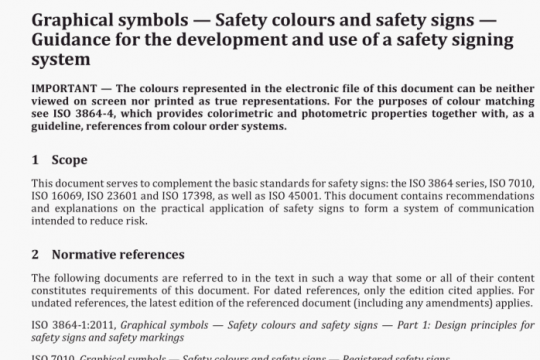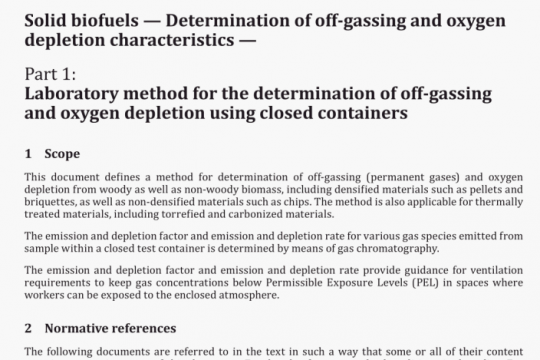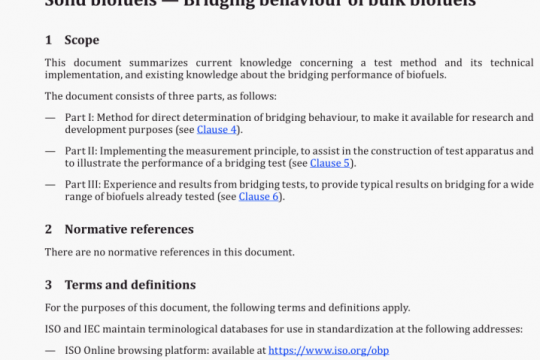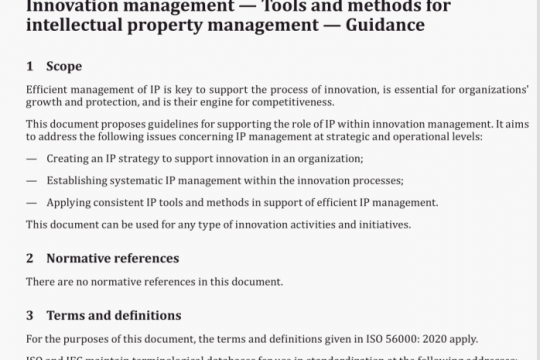ISO/TS 5660-5 pdf free download
ISO/TS 5660-5-2020 pdf free download.Reaction-to-fire tests – Heat release, smoke production and mass loss rate – Part 5: Heat release rate (cone calorimeter method) and smoke production rate (dynamic measurement) under reduced oxygen atmospheres.
5 Principle
The principle of this test method is based on the observation that, generally, both thermal and chemical products of a combustion reaction vary in quantity and quality depending on the atmospheric environmental conditions in which the reactions occurs. This test method provides a controlled environment to assess the contribution that a product under test can make to the rate of heat release, the production rate of gaseous products, and the smoke production rate, in different reduced oxygen atmospheres and/or differently ventilated atmospheres during the product’s involvement in fire. The properties are determined on small representative specimens. Specimens in the test are burned in ambient atmospheres or predetermined reduced oxygen atmospheres, while being subjected to a predetermined external irradiance within the range of 0 kW m2 to 50 kW m2. Measurements are made of oxygen and other gas concentrations in the exhaust, light transmission, exhaust gas flow rates, and specimen mass.
Heat release rate measurement is based on the observation that the net heat of combustion is proportional to the amount of oxygen required for combustion. The relationship is that approximately 13,1 x iO kJ of heat are released per kilogram of oxygen consumed. This is accurate within ±5 % for complete combustion and differs by ±20 % considerably for incomplete combustion. Measurements of oxygen concentrations and total exhaust gas flow rates are conventionally made. Enhanced measurements of carbon dioxide concentrations, carbon monoxide concentrations, other species concentrations, soot, water vapor, and unburnt fuel allow application of appropriate corrections depending on stoichiometries of the combustion reactions. These measurements are used to calculate the mass of oxygen consumed. Results are reported as heat release rate and total heat release, both normalized to exposed specimen surface area. The heat release rate of a burning specimen is calculated as the product of the oxygen mass consumed by the fire and the averaged proportionality 13,1 x i0 kJ kg1 with corrections for incomplete combustion. The enhanced measurements for carbon dioxide, carbon monoxide, and water vapor are applied for general corrections in this document. Where available, specific values for the proportionality can be used as quotient of the heat of combustion of a burning fuel and its stochiometric oxygen to fuel mass ratio. The total heat release is calculated by numerical integration of the heat release rate over the time interval being considered. Both variables are normalized to area because heat release is proportional to the burning surface area.
The principle of the smoke measurement Is based on the observation that, generally, the Intensity of light that is transmitted through a volume of combustion products is an exponentially decreasing function of distance. Measurements are made of exhaust gas obscuration, exhaust gas flow rate, and mass loss rate of the specimen. Exhaust gas obscuration is measured as the fraction of laser light intensity that is transmitted through the mixture of gases, aerosols, and particles in the exhaust duct. This fraction is used to calculate the extinction coefficient according to Bouguer’s law. In particular, with non- flaming and anaerobic pyrolysis processes, extinction coefficients differ from extinction values for combustion smoke. The test results are reported in terms of smoke production and smoke production rate, both normalized to exposed specimen surface area. Smoke production rate is calculated as the product of the extinction coefficient and the volumetric flow rate of the smoke in the exhaust duct. Smoke production is calculated by numerical integration of the smoke production rate over the time interval being considered. The variables reported are normalized to area because smoke production is proportional to area.
Gas production measurements are performed by measuring gas concentrations in the exhaust duct. Gas production rates are calculated from those concentration measurements utilizing general equations and relations. Species yields are derived from the specific gas mass flow rate divided by the actual fuel mass loss rate at the same time interval.
Atmospheric environmental conditions may range from approximately 1 % to 20,95 % of oxygen and 10 L/min to 1110 L/min volume flow rate. They are predetermined and controlled within the combustion environment by maintaining the ratio and volume flow rate of air and nitrogen gas respectively. The oxygen concentration in the atmospheric conditions and the total gas flow rate to the environment are monitored with relevant measurement devices. Air and nitrogen gas shall be provided either as bottled gases or as oil free pressurized air from a compressor, and liquid nitrogen vaporizer respectively.
NOTE Atmospheric environmental conditions can be characterised in terms of the Global Equivalence Ratio. Details are given in Annex A.
6 Apparatus
The apparatus described in this document allows measurement of reaction to fire behaviour under reduced oxygen atmospheres. Ranges of oxygen volume concentration below 20,95 % of oxygen can be studied. For those conditions above 15 % of oxygen, flaming combustion is usually expected. For those below 15 % of oxygen, flaming may occur but is generally not expected to occur for many products. Anaerobic pyrolysis experiments at close to 0 % of oxygen can be carried out in absence of the oxygen depletion measurements.
The apparatus utilizes the components and controls of the apparatus specified in ISO 5660-1 supplemented by apparatus modification detailed in this document to facilitate testing under reduced oxygen atmospheres. This principally consists of replacing the standard cone heater assembly by a second unit housed in a chamber that can by supplied with metered mixtures of air and nitrogen. Measurements are otherwise similar to those made in ISO 5660-1.
Optional gas measurement equipment shall be used as detailed in ISO 5660-1:2015, Annex G.
An apparatus exclusively for anaerobic pyrolysis experiments may alternatively utilize components and controls of the apparatus specified in ISO 13927.
A schematic representation of the apparatus required for this document is given in Ei.urei. Components described in ISO 5660-1 are marked. Components specific to reduced oxygen atmosphere testing are specified in 61 to 6.2 of this document.ISO/TS 5660-5 pdf download.




